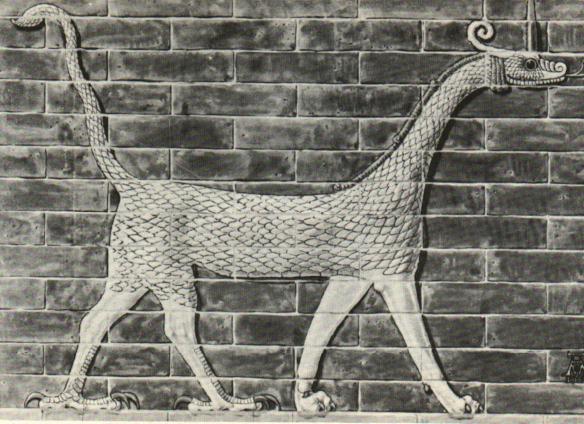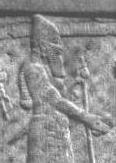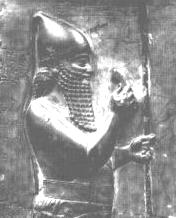Middle Babylonian Period (1155-627)
 |
| Dragon of Marduk, from the walls of Babylon |
This period can be divided into two sub-periods: the Middle Period (1156-979) and the Late Period (979-627). In the middle period, Babylon was always an independent power and, for a brief time, even considered a Great Power. The Late period is marked by Assyrian meddling and control.
4th Dynasty (also called the 2nd Isin Dynasty)
Marduk-Kabit-Ahheshu (1155-1146)-A prince of Isin. He retook Babylon from the Elamites and chased them out of the land. He also fought with the Assyrians, capturing Ekallatum.
Itti-Marduk-Balatu (1146-1132)-He fought the Assyrians.
Ninurta-Nadin-Shumi (1132-1126)-He fought the Assyrians.
Nebuchadrezzar I (Nabu-Kudurri-Usur) (1126-1103)-His actual name was Nabu-Kudurri-Usur. He attacked Elam but was repulsed. In his second campaign, the Elamite Prince Shitti-Marduk sided with him and he was able to overrun Elam, sack Susa and return the statue of Marduk to Babylon. This was not a lasting occupation, just revenge and plunder. The campaign destroyed Elam as a power.
Enlil-Nadin-Ahhe (Enlil-Nadin-Apli) (1103-1100)-His name is sometimes translated as Enlil- Nadin-Apli.
Marduk-Nadin-Ahhe (1100-1082)-Brother of Nebuchadrezzar. He sacked the Assyrian town of Ekallate. In retaliation, Tiglath-Pileser I swept down and captured Dur-Kurigalzu, Sippar, Opis and Babylon, but could not hold them. In the last year of his reign a severe famine struck the land. The chronicles say that the inhabitants of the Babylonian cities were reduced to eating human flesh and Marduk-Nadin-Ahhe "disappeared", i.e. he probably died.
The Arameans began putting pressure on Babylon and Assyria at about this time. They settled on agricultural lands and established tribal states, sometimes at the very outskirts of cities. By the 8thcentury they begin to settle in the cities themselves.
Marduk-Shapik-Zeri (1082-1069)-He went to Ashur to seek an alliance against the growing Aramean threat, but upon his return home he found that an Aramean by the name of Adad-Apal- Iddina had seized the throne.
Adad-Apal-Iddina (1069-1046)-An usurper of Aramean background. He seized the throne while the king was in Assyria. The Sutu, a Semitic tribe, plundered and destroyed the temple of Shamash in Sippar during his reign. It is also possible that Uruk, Der and Dur-Kurigalzu were either sacked by the Sutu or during uprisings against the king, but this by no means certain. Later the people of Babylon revolted, but they were put down.
Marduk-Ahhe-Eriba (1046)
Marduk-Zer-X (1045-1033)-The last part of his name is unknown, as the tablet is damaged.
Nabu-Shum-Libur (1033-1025)
5th Dynasty (also called the 2nd Dynasty of the Sealand)
Simbar-Shipak (1025-1008)-He was a Kassite from Sealand.
Ea-Mukin-Zeri (1008)-He reigned five months.
Kashu-Nadin-Ahhe (1007-1004)
6th Dynasty (also called the Bazi Dynasty)
Eulma-Shakin-Shumi (1004-987)-He was an Aramean from the tribal state of Bit-Bazi.
Ninurta-Kudurri-Usur I (987-985)
Shirikti-Shuqamuna (985)-He reigned three months.
7th Dynasty (also called the Elamite Dynasty)
Mar-Biti-Apla-Usur (984-979)-He was a soldier from Sealand, but he had an Elamite name.
8th Dynasty
Nabu-Mukin-Apli (979-943)-In the first several years of his reign, the capital was cut off from the surrounding area by the Arameans. In fact for nine years the New Years festival (the most holy of Babylonian festivals) could not be held because the outskirts of the city were not secure.
His successors are hardly more than names on a list, for the Kings List is often the only record of their reign.
Ninurta-Kudurri-Usur II (943)-He reigned eight months.
Mari-Biti-Ahhe-Iddina (942-c.920)
Shamash-Mudammiq (c.920-900)-He lost Hit and Zanqu to Adad-Nirari II of Assyria.
Nabu-Shuma-Ukin I (900-887)-He signed a treaty with Adad-Nirari of Assyria which guaranteed peace for 80 years.
Nabu-Apla-Iddina (887-855)-He restored the temple of Shamash in Sippar which had been destroyed 150 years earlier.
Marduk-Zakir-Shumi I (855-819)-His brother launched a rebellion with the support of the Arameans in 850.  The king called on Assyria, his powerful neighbor to the north for assistance. Shalmaneser defeated the rebels, entered Babylon and made offerings to the gods. He then chased the rebels into Sumer and all the way to the Gulf. In the process he temporarily established Babylon as a vassal. In gratitude, Marduk-Zakir-Shumi helped Shamshi-Adad V put down the great rebellion of 827-823. The Chaldeans are first mentioned (in the Assyrian Annals) during his reign. They lived amongst the swamps and lakes at the southern end of Mesopotamia and were a loose coalition of tribes organized into mini-states. By their refusal to submit to Assyria they, by default, became the champions of Babylonian independence.
The king called on Assyria, his powerful neighbor to the north for assistance. Shalmaneser defeated the rebels, entered Babylon and made offerings to the gods. He then chased the rebels into Sumer and all the way to the Gulf. In the process he temporarily established Babylon as a vassal. In gratitude, Marduk-Zakir-Shumi helped Shamshi-Adad V put down the great rebellion of 827-823. The Chaldeans are first mentioned (in the Assyrian Annals) during his reign. They lived amongst the swamps and lakes at the southern end of Mesopotamia and were a loose coalition of tribes organized into mini-states. By their refusal to submit to Assyria they, by default, became the champions of Babylonian independence.
Marduk-Balassu-Iqbi (819-813)-Possibly a vassal of Assyria, at least for part of reign. He was deposed by Shamshi-Adad V and carried off to Assyria.
Baba-Aha-Iddina (813-811)-Possibly a vassal of Assyria, at least for part of reign. He was deposed by Shamshi-Adad V and carried off to Assyria.
5 unknown kings (c.811-800)-Probably an interregnum, for the Kings List state that for several years "there was no king in the country".
Ninurta-Apla-X (c.800-790)-The last part of his name is unknown.
Marduk-Bel-Zeri (c.790-780)-Possibly an Assyrian vassal because Adad-Nirari III raided the Chaldeans in the south.
Marduk-Apla-Usur (c.780-769)-He was a Chaldean.
Eriba-Marduk (769-761)-A Chaldean, he was able to defeat an Aramean invasion and rid Babylonia proper of them. He is remembered by the later Chaldean kings as the true founder of their dynasty.
Nabu-Shuma-Ishkin (761-748)-His reign was plagued with unrest and civil war.
Nabonassar (Nabu-Nasir) (748-733)-His actual name was Nabu-Nasir. A much more accurate dating system began with his reign, based on astronomical phenomena. Tiglath-Pileser III of Assyria defeated an Aramean army threatening Babylon and made him a vassal.
Nabu-Nadin-Zeri (733-732)-Son of Nabonassar. He was killed in a revolt.
Nabu-Shuma-Ukin II (732)-He reigned one month. He was overthrown by Nabu-Mukin-Zeri.
9th Dynasty
Nabu-Mukin-Zeri (731-729)-He was an Aramean chief that seized the throne. The Assyrians tried to persuade the citizens of Babylon to raise against him. When they did not, they sent in the army. Nabu-Mukin-Zeri was killed in the taking of Babylon, along with his son. Babylon was annexed, but as a distinct province with-in the Empire and with the Assyrian king as king of Babylon.
Pulu (Tiglath-Pileser III) (729-727)-The Assyrian King. Pulu (the Pul of the Old Testament) was the name he took when ascending the Babylonian throne. From now on Assyria would dominate Babylonia. The northern cities, desiring peace, remained pro-Assyrian. In the south, the Chaldeans resisted Assyrian domination and became the champions of Babylonian independence.
Ululaju (Shalmaneser V) (727-722)-The Assyrian King. Ululaju was the name he took when ascending the Babylonian throne.
Marduk-Apal-Iddina II (Merodach-Baladan) (721-710)-He is called Merodach-Baladan in the Old Testament. He was a Chaldean who seized the throne with the help of Elam. He also claimed descent from Eriba-Marduk. In 720 Sargon marched on him, but was defeated by Humbanigash, the Elamite king. He reigned not as a barbarian chieftain, but as a great Mesopotamian monarch. In 710, Sargon invaded and pushed the Babylonians into the south. Defeated and wounded, Marduk-Apal-Iddina escaped to Elam.
He was a Chaldean who seized the throne with the help of Elam. He also claimed descent from Eriba-Marduk. In 720 Sargon marched on him, but was defeated by Humbanigash, the Elamite king. He reigned not as a barbarian chieftain, but as a great Mesopotamian monarch. In 710, Sargon invaded and pushed the Babylonians into the south. Defeated and wounded, Marduk-Apal-Iddina escaped to Elam.
Sargon (Sharru-Kin) (II) (709-705)-The Assyrian King. His actual name was Sharru-Kin.
Sennacherib (Sin-Ahhe-Eriba) (704-703)-The Assyrian King. His actual name was Sin-Ahhe- Eriba.
Marduk-Zakir-Shumi II (703)-When Marduk-Apal-Iddina revolted in the south, Marduk-Zakir- Shumi seized the throne, but only for one month, because Marduk-Apal-Iddina entered Babylon and was declared king.
Marduk-Apal-Iddina II (Merodach-Baladan) (703)-He reigned nine months. He returned from Elam and ignited all the Arameans in Babylonia into rebellion. He was able to enter Babylon and be declared king again. Nine months later he was defeated near Kish, but escaped to Elam with the gods of the south. He died in exile a couple of years later.
Bel-Ibni (702-700)-He was appointed by Sennacherib. In 700 Marduk-Apal-Iddina re-appeared in the south and stired up a revolt. Bel-Ibni was suspected of collusion and was taken away to Assyria. Sennacherib again chased Marduk-Apal-Iddina into Elam and appointed his son as the new Babylonian king
Ashur-Nadin-Shumi (699-694)-The son of Sennacherib. After six relatively peaceful years, the Assyrians and Babylonians launched a combined sea and land attack on Elam. Some coastal and border towns were occupied. In retaliation Elam invaded and sacked Sippar. Encouraged, the Babylonians revolted, seized Ashur-Nadin-Shumi and handed him over to the Elamites. They sent him back to Elam and he disappeared (he probably was murdered).
Nergal-Ushezib (693-692)-A puppet of Elam. He was captured by Assyria near Nippur and carried in chains to Assyria.
Mushezib-Marduk (692-689)-A Chaldean prince chosen by the local populace, who once again revolted with the support of Elam. The Assyrians met the Elamite/Babylonian army at the battle of Hallule. The Assyrians and Babylonians both claimed victory. Since Mushezib remained on the throne, it seems likely that the Assyrians were defeated, or at least suffered severe losses. The Elamite king Humban-Nimena suffered an incapacitating stroke in 689, depriving the Babylonians of their ally. Sennacherib struck and captured Babylon after a nine month siege. In retaliation for his son's death he did the unthinkable. He sacked and then destroyed Babylon. The walls were torn down and the Euphrates diverted into the city.
Sennacherib (Sin-Ahhe-Eriba) (688-681)-The Assyrian King. He crowned himself a second time. The destroyer of Babylon.
Esarhaddon (Ashur-Aha-Iddin) (680-669)-The Assyrian King. His actual name was Ashur-Aha- Iddin. He immediately began the rebuilding of the city. In 680, Merodach's son launched an unsuccessful attack on Ur. This was to be the only problem in the south during his reign. The people of Babylonia supported him because of his lavish rebuilding of Babylon. In fact, in 675, the Babylonians defeated an Elamite invasion by themselves.
Shamash-Shuma-Ukin (668-648)-Son of Esarhaddon. The Elamites invaded the land c.660 and again in 655, when their king was killed in battle. In 652 Shamash-Shuma-Ukin revolted against his brother with the support of Phoenicia, Judah, the Arabs, the Chaldeans and the Elamites, along with Lydian and Egyptian support. Ashurbanipal discovered the plot before it was hatched and invaded the south. For three years the war raged. After a two year siege of Babylon, in which the population had to resort to cannibalism, the city surrendered. In despair Shamash-Shuma-Ukin killed himself by setting fire to his palace. His brother entered Babylon and installed Kandalanu as viceroy.
Kandalanu (647-627)-He was installed as viceroy by Ashurbanipal. Possibly of Aramean origin.
Sin-Shum-Lishkar (627)-An Assyrian general. Upon the death of Kandalanu, he revolted, but was promptly ousted. Probably never recognized as, nor crowned king.
Sin-Shar-Ishkun (626)-Son of Ashurbanipal. He took possession of Babylon as king. Street battles erupted, stirred up by Nabopolassar, who had made himself king of the Sealand. Sin-Shar-Ishkun fled to Nineveh and Nabopolassar entered Babylon as king.


 The king called on Assyria, his powerful neighbor to the north for assistance. Shalmaneser defeated the rebels, entered Babylon and made offerings to the gods. He then chased the rebels into Sumer and all the way to the Gulf. In the process he temporarily established Babylon as a vassal. In gratitude, Marduk-Zakir-Shumi helped Shamshi-Adad V put down the great rebellion of 827-823. The Chaldeans are first mentioned (in the Assyrian Annals) during his reign. They lived amongst the swamps and lakes at the southern end of Mesopotamia and were a loose coalition of tribes organized into mini-states. By their refusal to submit to Assyria they, by default, became the champions of Babylonian independence.
The king called on Assyria, his powerful neighbor to the north for assistance. Shalmaneser defeated the rebels, entered Babylon and made offerings to the gods. He then chased the rebels into Sumer and all the way to the Gulf. In the process he temporarily established Babylon as a vassal. In gratitude, Marduk-Zakir-Shumi helped Shamshi-Adad V put down the great rebellion of 827-823. The Chaldeans are first mentioned (in the Assyrian Annals) during his reign. They lived amongst the swamps and lakes at the southern end of Mesopotamia and were a loose coalition of tribes organized into mini-states. By their refusal to submit to Assyria they, by default, became the champions of Babylonian independence. He was a Chaldean who seized the throne with the help of Elam. He also claimed descent from Eriba-Marduk. In 720 Sargon marched on him, but was defeated by Humbanigash, the Elamite king. He reigned not as a barbarian chieftain, but as a great Mesopotamian monarch. In 710, Sargon invaded and pushed the Babylonians into the south. Defeated and wounded, Marduk-Apal-Iddina escaped to Elam.
He was a Chaldean who seized the throne with the help of Elam. He also claimed descent from Eriba-Marduk. In 720 Sargon marched on him, but was defeated by Humbanigash, the Elamite king. He reigned not as a barbarian chieftain, but as a great Mesopotamian monarch. In 710, Sargon invaded and pushed the Babylonians into the south. Defeated and wounded, Marduk-Apal-Iddina escaped to Elam.